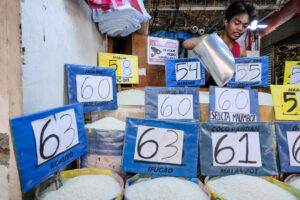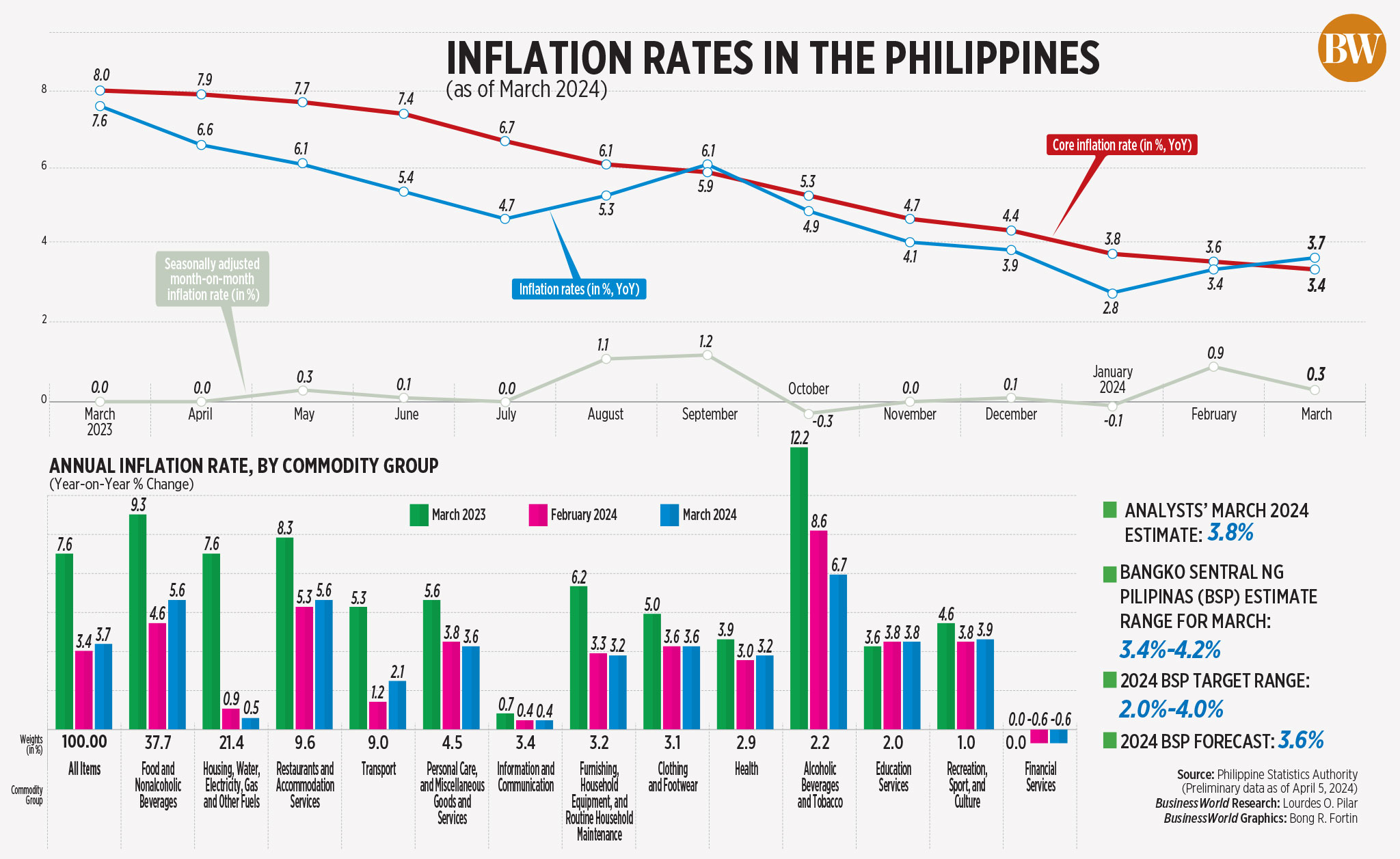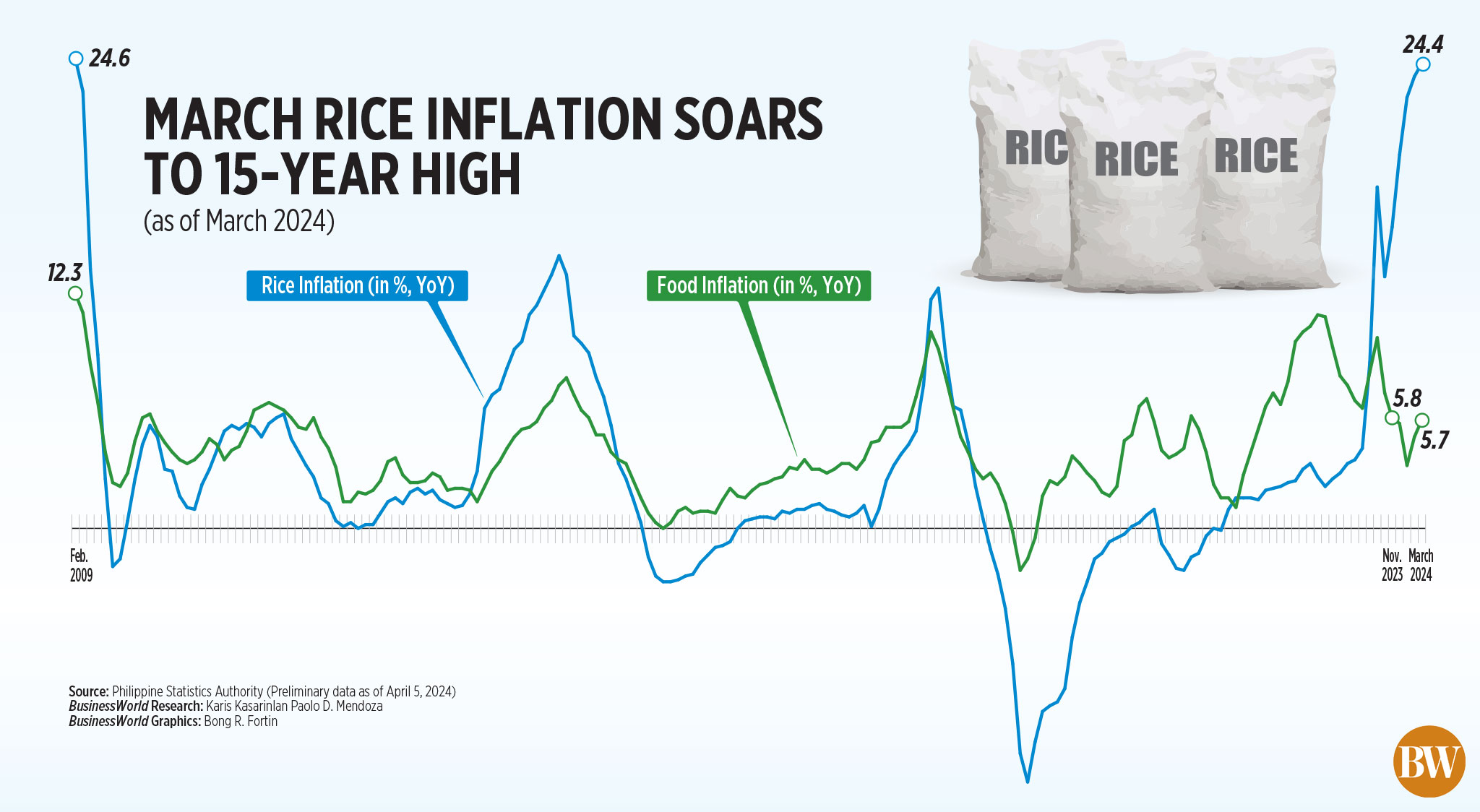




Quarterly Economic Growth Release: More BSP cuts to come
 DOWNLOAD
DOWNLOAD

Monthly Economic Update: Fed catches up
 DOWNLOAD
DOWNLOAD

Inflation Update: Steady and mellow
 DOWNLOAD
DOWNLOAD


Inflation accelerates for a second month in a row in March

Headline inflation quickened for a second straight month in March as prices of rice continued to surge, the Philippine Statistics Authority (PSA) reported.
Preliminary data from the PSA showed the consumer price index (CPI) accelerated to 3.7% year on year in March from 3.4% in February. This was slower than the 7.6% clip in the same month last year.
While inflation settled within the Bangko Sentral ng Pilipinas’ (BSP) 3.4-4.2% forecast for the month, it was slightly below the 3.8% median estimate in a BusinessWorld poll of 17 analysts conducted last week.
March marked the fourth straight month that inflation was within the BSP’s 2-4% target range.
Month on month, inflation picked up by 0.1%. Stripping out seasonality factors, month-on-month inflation rose by 0.3%.
For the first quarter, inflation averaged 3.3%. The BSP expects average inflation to settle at 3.6% this year.
Core inflation, which excludes volatile prices of food and fuel, eased to 3.4% in March from 3.6% in February and 8% a year ago.
“The inflation outturn is consistent with the BSP expectations that inflation will likely remain within the target range in the first quarter of 2024 due largely to negative base effects,” the BSP said in a statement.
“However, inflation could temporarily accelerate above the target range in the next two quarters of the year due to the possible adverse impact of adverse weather conditions to domestic agricultural output and positive base effects,” it added.
National Statistician Claire Dennis S. Mapa said March inflation was mainly driven by the heavily weighted index for food and nonalcoholic beverages, which quickened to 5.6% from 4.6% in the previous month. However, it was much slower than the 9.3% print in 2023.
Food inflation rose to 5.7% in March, its fastest print in four months or since the 5.8% recorded in November 2023. This was also faster than the 4.8% logged in February but slower than the 9.5% in the previous year.
“Food inflation shared 55.2% or 2.0 percentage points (ppt) to the overall inflation in March 2024,” the PSA said.
HIGH RICE PRICES
Among the top food groups that contributed to food inflation were cereals and cereal products and meat and other parts of slaughtered land animals, it added.
Cereal and cereal products, which includes rice, quickened to 17.3% in March from 17% in the previous month and 5.5% in the same period in 2023.
Rice inflation climbed to 24.4% in March, from 23.7% in February and 2.6% a year ago. This was also its fastest print since the 24.4% in February 2009.
“Since this particular commodity started increasing in terms of its prices and inflation, our expectation is that it will remain high until July,” Mr. Mapa said.
Rice inflation contributed 1.8 ppt to headline inflation or around 48% of the total.
For the bottom 30% households, the contribution of rice inflation was at 3.7 ppt or almost 80% of overall inflation for the month.
“Just to give you an idea, the weight of rice in our commodity basket for all incomes is almost 9%. That’s the highest in terms of weight in our commodity basket. It’s even higher for our bottom 30% income households, it reaches 17.9%, so close to double,” Mr. Mapa said.
Rice inflation is expected to remain in the double-digit area over the next few months, he said.
“Our expectation is that it will actually increase strongly until around July because of the base effects, unless there is really some intervention that will happen in the markets to cause prices to decline,” Mr. Mapa added.
PSA data showed that the average price of a kilogram of regular milled rice increased to PHP 51.11 in March from PHP 50.44 a month ago and PHP 39.90 a year earlier.
Well-milled rice rose to PHP 56.44 per kilogram in March from PHP 55.93 in February and PHP 44.23 in the previous year. Special rice averaged PHP 64.75 per kilogram in March from PHP 64.42 in the previous month and PHP 54 a year ago.
Mr. Mapa also attributed faster rice inflation to elevated world rice prices and higher palay (unmilled rice) prices.
“The price of palay is high. Our February average is at around PHP 28.29 (per kilogram). This has been increasing,” he said.
“Although of course, the farmers are worried about the weather. I think for the first quarter, there were farms that still had high production although there were also farms, especially those without access to irrigation, that’s where there are problems. But the price of palay is increasing, so that is one major factor why rice is increasing.”
The El Niño weather event has caused dry spells and droughts in parts of the country. Agricultural damage caused by the El Niño has risen to PHP 2.63 billion, with rice being the most affected crop.
“The government is closely monitoring weather conditions and their effects on the supply of key commodities, such as food and energy, to protect Filipino households from sudden price increases,” National Economic and Development Authority (NEDA) Secretary Arsenio M. Balisacan said in a statement.
Meanwhile, inflation for meat and other parts of slaughtered land animals increased to 2%. This was faster than the 0.7% a month ago but slower than the 4.6% a year earlier.
Mr. Mapa said that prices of meat, particularly pork, increased in March.
The average price of a kilogram of pork shoulder (kasim) rose to PHP 329.52 in March from PHP 315.29 a year ago. Prices of pork belly (liempo) increased to PHP 344.29 per kilo from PHP 327.27 in the previous year; while prices of a kilo of pork meat with bones went up to PHP 297.30 from PHP 286.49 in 2023.
Meanwhile, transport inflation rose to 2.1% in March from 1.2% in the previous month. However, it was slower than the 5.3% a year ago.
“Month on month, there is an increase in the prices of oil products, gasoline and diesel. There’s really an impact there. We see that in the increase of tricycle fares, that’s one of the contributors,” Mr. Mapa said.
In March alone, pump price adjustments stood at a net increase of PHP 2.30 a liter for gasoline, PHP 0.65 a liter each for diesel and kerosene.
Mr. Mapa noted that the higher tricycle fares was largely felt outside of the National Capital Region (NCR).
Data from the PSA showed that the average fare for tricycles outside of NCR rose to PHP 17.80 in March from PHP 17.72 in February and PHP 17.50 a year ago.
Meanwhile, the inflation rate for the bottom 30% of income households rose to 4.6% in March from 4.2% in the previous month. However, it was much slower than the 8.8% clip in the year ago.
From January to March, inflation averaged 4.1% for the bottom 30%.
In the NCR, inflation averaged 3.3% in March, faster than the 3.2% a month ago but slower than the 7.8% recorded in the same month in 2023.
Inflation outside of NCR accelerated to 3.8% from 3.5% in February but was slower than the 7.5% in the previous year.
RISKS TO INFLATION
With the recent uptick in March, the BSP said that risks to the inflation outlook remain tilted toward the upside.
“The upside risks to the inflation outlook could emanate from higher transport charges, higher prices of food commodities facing supply constraints, increased electricity rates, higher global oil prices, and implementation of a legislated increase in the minimum wage,” it added.
HSBC economist for ASEAN (Association of Southeast Asian Nations) Aris D. Dacanay said that inflation may breach the 2-4% target band in the coming months.
“The numbers are consistent with our view that headline CPI will eventually breach the central bank target in the second quarter of 2024, which may, perhaps, result in some market jitters,” he said.
“Looking closely, however, the rise is mostly due to unfavorable base effects. Once these base effects wear off in August, inflation should immediately return to within the BSP’s target band,” he added.
Bank of the Philippine Islands (BPI) in a commentary said that El Niño may continue to stoke inflation.
“Looking ahead, inflation may accelerate further beyond the 4% target of the BSP in the second quarter despite the lower-than-expected March figure, with El Niño as the main driver. Supply of certain food items will likely remain tight until El Niño subsides,” it said.
El Niño has shown signs of weakening but is still expected to persist until May, according to the state weather bureau.
“BSP indicated that it expects inflation to edge past the upper end of its 2-4% inflation target band in the coming months due to tight supply for agriculture products because of the El Nino induced drought,” ING Bank N.V. Manila Senior Economist Nicholas Antonio T. Mapa said in an email note.
China Bank Research said that inflation will remain on an uptrend and breach the target range until July, driven by “unfavorable base effects.”
HSBC’s Mr. Dacanay also noted that rice prices will also remain a key concern.
“Remember that global rice prices steeply rose in August last year. Global rice prices are still elevated but Executive Order 50, which extended the lower tariff rates for rice, has stemmed the extent of how much domestic rice prices can surge,” he said.
With these risks, analysts said that the BSP will likely keep its benchmark rate steady at its policy review on April 8 (Monday).
“We believe the BSP may extend its pause beyond the upcoming April meeting with a potential rate cut only likely in the second half of the year,” Mr. Mapa said.
The Monetary Board kept its key rate steady at a near 17-year high of 6.5% for a third-straight meeting in February. The BSP hiked borrowing costs by 450 basis points (bps) from May 2022 to October 2023.
“The BSP will likely remain cautious still, especially in light of upside risks such as the recent rise in global oil prices. We expect the BSP to hold its policy rate at its meeting next week, with the fourth quarter of 2024 as the likely start of monetary easing,” China Bank Research said. — By Luisa Maria Jacinta C. Jocson, Reporter
This article originally appeared on bworldonline.com





 By BusinessWorld
By BusinessWorld

